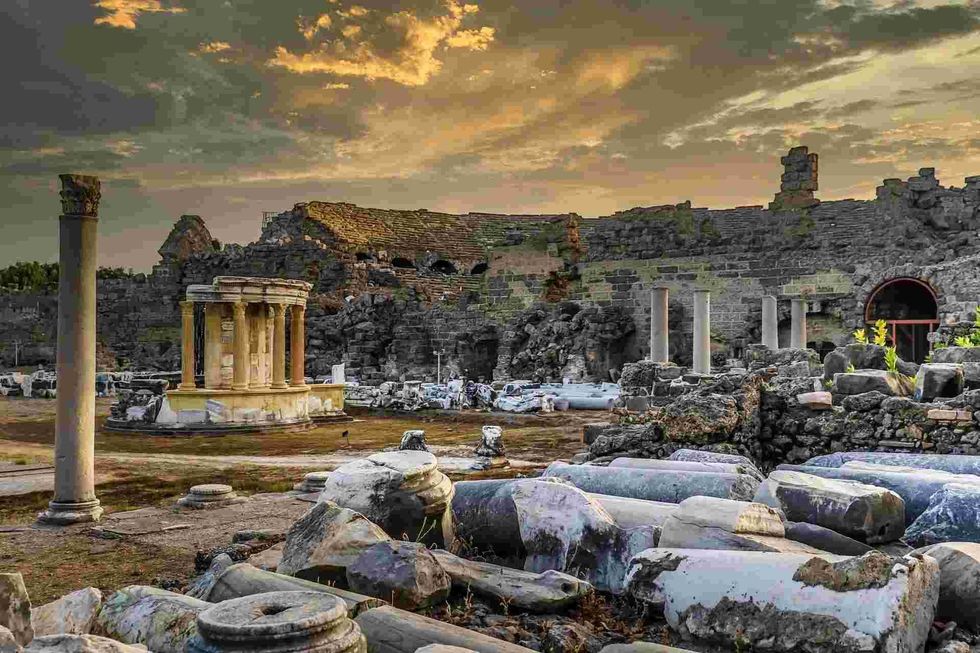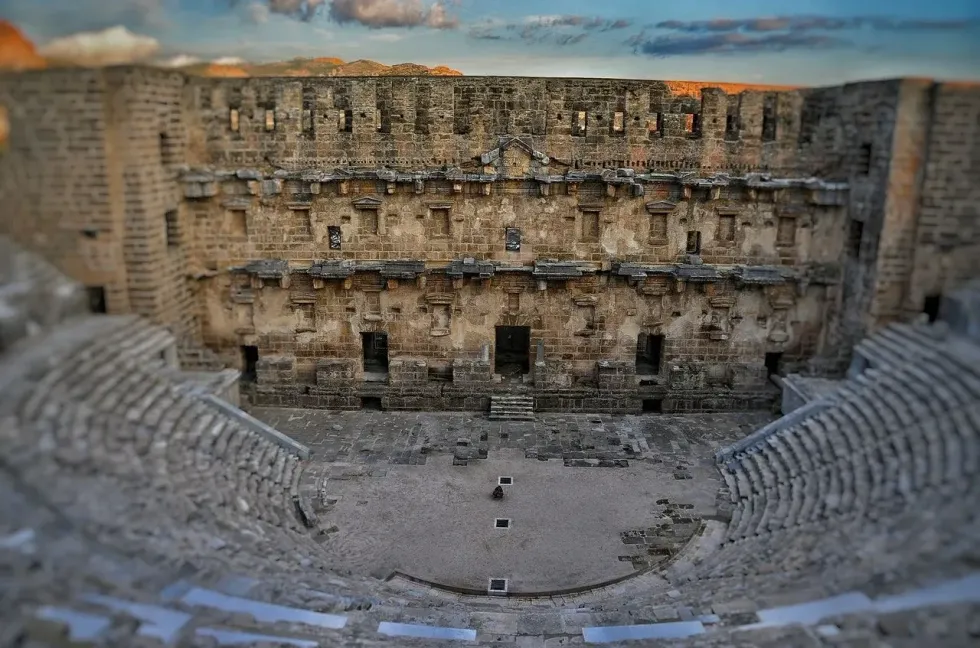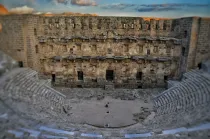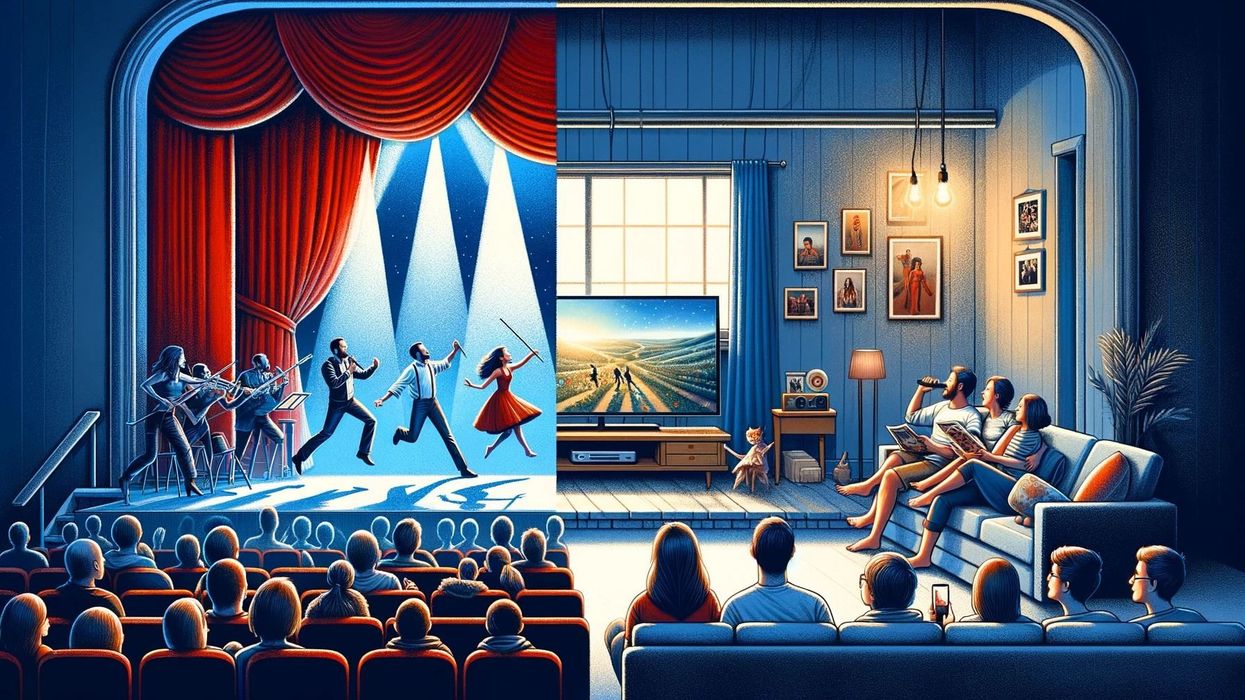Ancient Roman Theater Facts: Roman Critics, Playwrights, and More

Ancient Roman theater included a variety of entertainment that the Romans enjoyed.
Ancient Roman theater featured dance, music, and dramatic reenactments of numerous stories. The Romans were huge fans of all forms of entertainment, and certain famous plays were even produced to worship the gods.
The Roman Republic was established in 509 BC. Ancient Romans began holding rites known as Lectisterniums almost 100 years later, in 399 BC. These rituals were employed to provide sacrifices to Roman gods. They were a predecessor to the formation of theater while not being dramatic in nature.
The Theater of Pompey, dedicated in 55 BC by Julius Caesar's competitor, Pompey the Great, was the first permanent theater in the city of Rome.
The theater, of which only the foundations have survived, was a massive construction with a height of 147 ft (45 m) and a capacity of 20,000 spectators. Dances to flute music, obscene improvisational verse, medleys of dances to flute music, comedies with plot lines, and portions of lyric poetry sung are the five phases of Roman theater.
There were female playwrights, female actors on stage that played important female characters, and many women attended the theater.
The old Roman Forum and Shakespeare's Globe Theatre have a few parallels. Horace and Longinus are two well-known Roman critics whose critical writings were founded on poetic invention.
The progression of Ancient Greek theaters led to the development of Roman theaters. Indeed, the Greeks had a significant architectural effect on the Romans, and theater architectural integrity would have been no different from that of other structures.
Roman theaters, on the other hand, were distinct in that they were often built on their own foundations rather than earthen works or a hillside, and they were totally enclosed on all sides.
From Spain to the Middle East, Roman theaters were erected all around the Empire. Due to the Romans' capacity to influence local design, there are various theaters with distinctive Roman characteristics throughout the world.
If you like this article, you may find it interesting to read these Ancient Roman baths facts and Ancient Roman clothes facts here on Kidadl.
Origins Of Roman Theater
Although the origins of Roman theatrical traditions are unknown, they were a part of Roman society and a huge part of Roman history. The Etruscans, who lived nearby, were known for a variety of theatrical arts, many of which were employed in religious ceremonies.
In reality, during times of crisis and starvation, the Romans paid Etruscan entertainers to come to Rome.
Romans kept performing as part of their religious festivities throughout the early Roman Republic. While Romans treasured many kinds of amusement and spectacles, the Ludi Romani, an athletic tournament in honor of the Roman god Jupiter, was one of their earliest Roman festivals.
This event included pop-up performances performed by professional actors and was supported by a local politician or wealthy merchant around the third century BC.
Around the same time, Livius Andronicus, the first authentic Roman playwright, wrote one of the first full-length Latin tragedy plays. If the quality of theater reflects the ideals of the society from which it emerged, then the destiny of theater in Roman times exemplifies this.
Nearly all Roman plays were imitations or rough translations of Greek dramas, even to the point of being presented in Greek dress due to public taste, a lack of innovation, and a penchant for the show over seriousness.
Greek theater appeared to come to an end after 400 years of contending with chariot races and gladiatorial combat to the death.
Several reasons should be considered when explaining why this occurred, but one of the most important was how Roman rulers employed circuses and Roman public games where theatrical acts were held, to divert the public's attention away from economic and political unrest.
The number of sanctioned festivals increased dramatically.
When the drama was initially introduced around 240 BC, the games lasted less than a week.
The origins of Roman theater can be traced back thousands of years. After the formation of the Roman Republic in fourth century BC, it is assumed that theatrical performances began in Ancient Rome.
However, the majority of the oldest known instances of Roman theater are from 200-300 years later, beginning in the third century AD, before the Roman Empire fell.
Theatrical performances formed an important element of Roman life during this time period, frequently serving as social comments. In 364 BC, a plague epidemic across the Roman Republic was seen as a symbol of the gods' displeasure at these sacrifices.
Rome's residents began integrating theatrical games and dance in their Lectisterniums in order to satisfy the gods and stop any more calamities.
It wasn't long before they became organized concerts, both as part of the Lectisterniums and on their own. Early scripts in the form of brief sentences were employed at this period, and music and dancing were popular.
Theatrical Spaces And Stages
Roman dramas were acted by professional actors at practically every public religious event by the time the Roman Empire began in the first century AD. The Roman calendar included approximately 200 days of these events, so the Romans had plenty of opportunities to see them.
The elevated stage was the greatest distinguishing element of Roman theater in comparison to Greek theater. Roman theaters are distinct in that they were often built on their own foundations rather than earthen works or a hillside, and they were totally enclosed on all sides.
The sitting space (cavea) was confined to a semicircle since every seat had to have a view of the stage. The scaenae frons, the scene building behind the stage, was utilized as both the rear scene and the performers' dressing room, like it was in Greek theater.
It was no longer painted in Greek culture but instead included architectural details as well as lavish ornamentation.
The audience was seated on spectacula, or layers of wooden seats, which were supported by scaffolding. The rear scene, with its three entrances, faced the audience with no curtain.
There were three different types of temporary stage structures. The first was the simple low stage, which consisted of a crude platform with a hardwood floor supported by three or four rectangular supports.
The second was a stage with low supports and draperies or tablets. Stairs went up to a platform, and a door was occasionally represented. A taller stage supported by columns, without stairs but frequently with a rear wall, was the third form.
In the middle of the stage, there was a short flight of five to seven stairs leading to the podium. The forewall was frequently draped with curtains, while the background wall was frequently hung with artifacts.
Other columns, in addition to the ones at the corners, were occasionally added to the back wall, as well as doorways and, in some cases, windows, to indicate a higher story.
An ornamented porch with a sloping or gabled roof supported by beams and cross struts was frequently used to conceal the entry. There were generally trees, altars, chairs, thrones, a dining table, a money box, and an Apollo tripod as decorations (an oracular seat).
In smaller towns, the stage was put up in the marketplace, whereas in larger cities, it was set up in the orchestras of Greek theaters.

Structure Of The Roman Theater
Pompey supported the construction of a permanent theater in 55 BC. However, the Romans created temporary wooden constructions as performance places, as documented by the Roman architect, engineer and writer Vitruvius (late first-century BC). They continued to do this long after the invention of permanent theaters.
As class differences and personal sponsorship of performance events grew, such as the yearly Ludi Romani (Roman Games), circuses, and other spectacles, the creation of temporary theatrical venues allowed for luxurious seats and lavish decorative embellishments, and funeral celebrations for the wealthy and notable.
The widening split between the aristocracy and the working class created a dread of seditious activity, and permanent theaters provided a made-to-order venue for public meetings and mass communication.
Theaters were built-in public locations such as the Forum, Campus Martius, or the Circus as needed for festivals and other events.
The Greek, Etruscan, and early Roman theatrical influences, as well as early Roman exhibitions and rites, all had an impact on the development of Roman theater.
Due to the the transitory nature of these wooden theaters, the Romans were able to make changes as needed rather than following the Greek and Hellenistic models mindlessly, resulting in a performance space that was unique.
Some emperors were disdainful of them, as one might anticipate, and took attempts to damage their reputation. Theaters were constructed into a hillside for ready-made tiered seating, with an elevated Roman stage, an orchestra separating the performing platform from the audience, and side entrances.
Theaters and amphitheaters of Ancient Rome had a lot in common. They were made of the same material, Roman concrete, and used as public gathering places for a variety of activities.
They are, however, two completely separate structures with distinct designs that cater to the various events they hosted. Unlike the building of a Roman theater, amphitheaters did not require great acoustics.
Famous Roman Actors
Quintus Roscius Gallus was a well-known actor in the first century BC. Roscius was born in Latium to an equestrian family and was a personal friend of Cicero, who represented Roscius in court on an allegation of commercial fraud about 69 BC.
Women appear to have been permitted to act in mime and a variety of other productions, including pantomime, private celebrations, and festivals. Lycoris had the stage name Volumnia Cytheris and was the mistress of some of Rome's most influential people in the first century BC.
She was one of the most well-known mime actors.
The Middle Ages' theater was inherently participatory, and it maintained a closeness between actors and audience throughout its evolution. Women were known to act in revivals of Roman comedies, as well as mimes and other plays, near the end of the Roman Empire
While the Ancient Greeks admired actors as interpreters of Greek poets' and authors' epic Roman comedies and tragedies, the Romans had a different perspective. Actors were believed to be on the same level as laborers in terms of social position.
Many performers were either slaves-in-service to a company management or emancipated servants who joined a company of theatrical actors after purchasing their freedom. Many others were foreigners or prisoners.
Acting was mostly passed down down the generations, yet Roman people were not permitted to pursue careers as performers. Roman performers had a bad reputation in terms of lifestyle, and their morality challenged even the decadence of Roman society.
Some emperors were critical of them and took steps to mitigate their popularity. Emperor Julian the Apostate forbade pagan Roman priests from attending theatrical performances in order to prevent the performances from gaining respectability, and Emperor Tiberius, who was more enlightened, stopped people on the stage from having any contact with the upper classes.
The majority of Roman plays were whimsical, more mimes and pantomimes than epic tragedies. The masterpieces we know and admire were in the minority.
Notable Roman Playwrights
Famous Roman playwright works, such as Plautus' between 205 and 184 BC, consisted of 50 plays, many of which have survived. His dialogue was praised for its humor and use of a range of poetic meters.
Plautus was a prolific playwright who produced roughly 50 works. Amphitryon, Bacchides, The Casket Comedy, Mercator, and Persa are some of the most notable Roman plays that have survived. In the the play, 'A Funny Thing Happened On The Way To The Forum', he had an admirable sense of humor.
Terence wrote six comedies during his life. These were 'The Andrian Girl' (166 BC), 'The Mother-In-Law; (165 BC), 'The Self-Tormentor; (163 BC), 'The Eunuch' (161 BC), 'Phormio' (161 BC), and 'Adelphi: The Brothers' (165 BC).
Terence's six comedies, written between 166 and 160 BC, have all survived. The intricacy of his plays usually merged many Greek originals, and this was criticized at times, However his double-plots allowed for a profound portrayal of clashing human conduct.
Seneca (4BC-65AD) was the most famous Ancient Roman tragedy playwright, and he adapted plays from Greek authors. His plays strained the limits of Ancient Rome, and he was sentenced to death by Nero in 65 AD because of offensive remarks in one of his plays.
Seneca consented and he requested poison. When it didn't work, his servants put him in a hot copper bath, where the steam smothered him to death.
Seneca wrote nine tragedies, all of which were based on Greek originals. 'Phaedra', for example, was inspired by Euripides' 'Hippolytus'.
Seneca was a first-century playwright well known for his Roman translations of Greek tragedies, such as Medea and Phaedra.
A Greek servant brought to Rome around 240 BC, Livius Andronicus, created plays based on Greek topics and existing plays. Plautus, a third-century BC humorous playwright and author of 'Miles Gloriosus', 'Pseudolus', and 'Menaechmi Terence', wrote between 170 and 160 BC Titinius, a second-century BC dramatist, wrote between 170 and 160 BC.
Gaius Maecenas Melissus was a playwright in the first century who wrote a Roman comedy named 'Comedy of Manners'. Ennius, a contemporary of Plautus and a playwright, composed both comedies and tragedies.
Pacuvius, Ennius' nephew and tragic playwright Lucius Accius, was a tragic poet and scholar of Roman literature. To thank the gods, plays were performed at religious rites. Christians demonstrated outside theaters, asking for the censoring of offensive performances, and even sought to outlaw the Greek art form entirely.
Roman Theater In Performance
While Etruscan and Greek predecessors affected Roman theater, the mentality was essentially Roman. The Ludi Romani, an athletic tournament in honor of the god Jupiter, was held in the early days of Rome, and theatrical plays were frequently tied with religious festivals.
Instead of drama and storytelling, the emphasis was purely on amusement, with Roman performances resembling today's circus acts. The people of Rome wanted a spectacle! Singing and dance, as well as mime, were prominent in presentations.
Temporary wooden buildings were used for theatrical performances, which had to be shifted and dismantled for days at a time whenever new spectacular events were scheduled because these plays were less popular than the other types of events, such as gladiatorial matches and circus events, held within the same space.
Here at Kidadl, we have carefully created lots of interesting family-friendly facts for everyone to enjoy! If you liked our suggestions for Ancient Roman theater facts, then why not take a look at Ancient Roman culture facts or Ancient Roman art facts.
We Want Your Photos!
More for You
Master of Computer Science

Abhijeet ModiMaster of Computer Science
An experienced and innovative entrepreneur and creative writer, Abhijeet holds a Bachelor's and Master's degree in Computer Application from Birla Institute of Technology, Jaipur. He co-founded an e-commerce website while developing his skills in content writing, making him an expert in creating blog posts, website content, product descriptions, landing pages, and editing articles. Passionate about pushing his limits, Abhijeet brings both technical expertise and creative flair to his work.
Disclaimer
1) Kidadl is independent and to make our service free to you the reader we are supported by advertising. We hope you love our recommendations for products and services! What we suggest is selected independently by the Kidadl team. If you purchase using the Buy Now button we may earn a small commission. This does not influence our choices. Prices are correct and items are available at the time the article was published but we cannot guarantee that on the time of reading. Please note that Kidadl is a participant in the Amazon Services LLC Associates Program, an affiliate advertising program designed to provide a means for sites to earn advertising fees by advertising and linking to Amazon. We also link to other websites, but are not responsible for their content.
2) At Kidadl, we strive to recommend the very best activities and events. We will always aim to give you accurate information at the date of publication - however, information does change, so it’s important you do your own research, double-check and make the decision that is right for your family. We recognise that not all activities and ideas are appropriate for all children and families or in all circumstances. Our recommended activities are based on age but these are a guide. We recommend that these ideas are used as inspiration, that ideas are undertaken with appropriate adult supervision, and that each adult uses their own discretion and knowledge of their children to consider the safety and suitability. Kidadl cannot accept liability for the execution of these ideas, and parental supervision is advised at all times, as safety is paramount. Anyone using the information provided by Kidadl does so at their own risk and we can not accept liability if things go wrong.
3) Because we are an educational resource, we have quotes and facts about a range of historical and modern figures. We do not endorse the actions of or rhetoric of all the people included in these collections, but we think they are important for growing minds to learn about under the guidance of parents or guardians.







